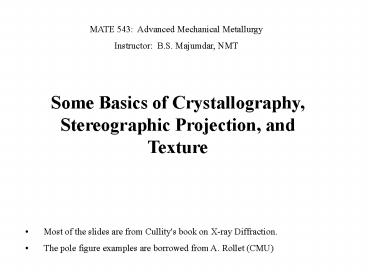Some Basics of Crystallography, Stereographic Projection, and Texture - PowerPoint PPT Presentation
1 / 27
Title:
Some Basics of Crystallography, Stereographic Projection, and Texture
Description:
If the goniometer is set for {100} reflections, then all directions in the ... The example shows a crystal oriented to put all 3 100 directions approximately ... – PowerPoint PPT presentation
Number of Views:1590
Avg rating:3.0/5.0
Title: Some Basics of Crystallography, Stereographic Projection, and Texture
1
MATE 543 Advanced Mechanical Metallurgy Instruct
or B.S. Majumdar, NMT
Some Basics of Crystallography, Stereographic
Projection, and Texture
- Most of the slides are from Cullity's book on
X-ray Diffraction. - The pole figure examples are borrowed from A.
Rollet (CMU)
2
(No Transcript)
3
(No Transcript)
4
(No Transcript)
5
(No Transcript)
6
(No Transcript)
7
Reciprocal Lattice
8
(No Transcript)
9
(No Transcript)
10
(No Transcript)
11
(No Transcript)
12
(No Transcript)
13
(No Transcript)
14
(No Transcript)
15
(No Transcript)
16
(No Transcript)
17
(No Transcript)
18
(No Transcript)
19
Pole Figure Example
- If the goniometer is set for 100 reflections,
then all directions in the sample that are
parallel to lt100gt directions will exhibit
diffraction. The example shows a crystal oriented
to put all 3 lt100gt directions approximately
equally spaced from the ND.
20
Cube Texture (100)001 cube-on-face
- Observed in recrystallization of fcc metals
- The 001 orientations are parallel to the three
ND, RD, and TD directions.
21
Sharp Texture (Recrystallization)
- Look at the (001) pole figures for this type of
texture maxima correspond to 100 poles in the
standard stereographic projection.
22
Miller Index Definition of a Crystal Orientation
- We use a set of three orthogonal directions as
the reference frame. Mathematicians set up a set
of unit vectors called e1 e2 and e3. - In many cases we use the names Rolling Direction
(RD) // e1, Transverse Direction (TD) // e2, and
Normal Direction (ND) // e3. - We then identify a crystal (or plane normal)
parallel to 3rd axis (ND) and a crystal direction
parallel to the 1st axis (RD), written as
(hkl)uvw.
23
The cubic crystal axes are shown with respect to
the specimen laboratory axis. Oz is the surface
normal. While the in-plane directions can be
arbitrary, the direction Oy is selected to
coincide with the loading direction of the
sample. All the green dashed lines lie on the
specimen surface. The angles between specimen
axes and crystal axes are represented by Bunge's
Euler angles f1, F, and f2, such that from an
initial coincident axes system, the 100-010 plane
is rotated by f1 about the 001 axis (initially
same as z-axis), then the 001-101 plane is
rotated about the new 100 axis by angle F, and
finally the 100-010 plane is rotated again about
the new 001 axis by angle f2.
24
Euler Angles
25
Complete orientations in the Pole Figure
f1
(f1,?,f2) (30,70,40).
Note the loss ofinformationin a
diffractionexperiment if each set of poles from
a single component cannot be related to one
another.
f2
F
f1
F
f2
26
X
-110
010
45
001
Y
111
Z
55
55
11-2
100
45
180
Red symbols show the correspondence of XYZ with
respect to the crystal axis The angles determine
how the crystallographic axes are located with
respect to the specimen axis. Z is the specimen
normal, and X and Y are the in-plane axes of the
previous figure. Initially X, Y, and Z correspond
to 100, 010, and 001 axes, respectively. After
the Euler rotations, the axes split apart as
shown..
27
(No Transcript)































